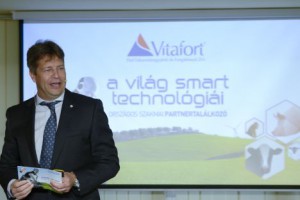Hungary to Receive Euro 3.4 billion in Rural Development Funding

In the coming 7 years between 2014 and 2020, Hungary expects to receive a total of some 3.4 billion euros in rural development funding, emphasised Minister of State for Rural Development Zsolt V. Németh at the 4th HUNAGI mobile GIS geoinformation conference.
Zsolt V. Németh said that the level of EU joint financing in less developed regions will be 75 percent, and 53 percent in more highly developed regions. An important change is that it will also become possible to fund VAT, if that may not be refunded according to national law. It will be especially significant to the planning of development projects that following the end of the seven-year cycle, the settlement of funding accounts may be performed for a further three years instead of the current two.
The Minister of State also reported on EU priorities, stressing that only projects that are linked to at least one of the elements may be realised. The EU is supporting the transfer of knowledge and innovation, increasing competitiveness, the risk management of the food chain, the preservation and improvement of ecosystems, resource efficiency, the reinforcement of social inclusion and the reduction of poverty. Mobile GIS technology may prove helpful with regard to the preservation of ecosystems.
May important changes will occur in the implementation of the rural development programme in the upcoming period. Instead of division according to axes, member states may choose from a package of measures. It will be possible to launch new, thematic programmes, and Hungary is sure to launch a programme of this nature to support young farmers and encourage shorter food chains. Local development projects managed by communities will receive greater emphasis. At least 25 percent of funding must be used to reduce climate change.
In future, unfavourable areas will become Areas with Natural Handicaps (ANH), which will be designated according to 8 biophysical criteria (e.g. water scarcity, excess groundwater, steep slope). Mobile GIS technology could play a role in the designation of land areas, Zsolt V. Németh pointed out.
The Hungarian Association for Geoinformation, HUNAGI, was founded in 1994, and it has been operating as a non-profit company since 2002. the organisation’s fourth conference entitled „How can geoinformation and remote sensing help us achieve a more liveable environment” was organised for the representatives of small and medium-sized geoinformation enterprises, academic and educational developers, local government and non-governmental organisations.











Vélemény, hozzászólás?
Hozzászólás küldéséhez be kell jelentkezni.